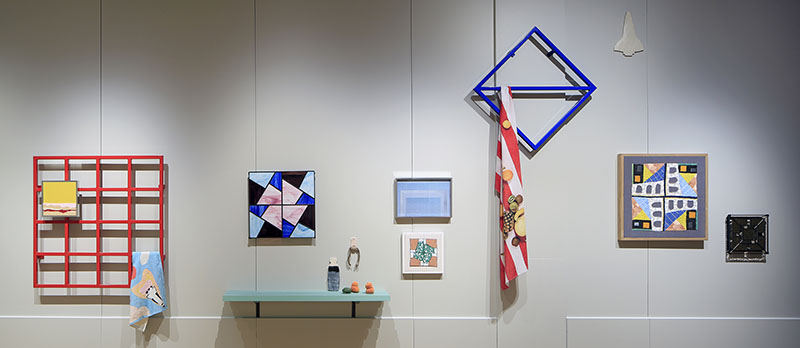Erica van Zon – Creating Connections
A mixed media collection of artworks, interlinked by visual clues and underlying narratives, Erica van Zon’s exhibition at Sarjeant on the Quay ranges widely through time and physical space.
Entitled Opal Moon, Local Lime the show is the result of three months she spent in January to March 2016 as artist in residence at Tylee Cottage. In this project Ms van Zon set out to show the “workings of her brain”, the connections and associations she makes, starting with local objects and events as a stimulus and seeing where they led.
Initial inspiration came from the tiles on the modernist façade of the Maori Land Court Annex, in Market Place, thought to have been designed by architect Don Wilson.[1]
“It’s a beautiful building and I was particularly drawn to the tiles. They reflect the awa – black with wiggly mustard lines and scratchy blue marks.”
She made a beaded artwork based on the tiles, which led into a narrative about Don Wilson and further research at the city archives. It was later discovered that the tiles were not designed by Wilson, but this research led to further connections.
“Then by pure luck and happenstance one of my friends had access to a Don Wilson house that he built for his family on St Johns Hill. I went there and made an artwork about stereo speaker covers that have a rippled, linear design, which reminded me of the surface of water in a David Hockney painting.”
That association inspired an artwork about the surface of water, and another followed.
“I kept incorporating other threads back into the work I was making. When you see the show it looks like a cacophony of different things coming together. But they are structured groupings that are conceptually linked.”
Another stimulus was the 30th anniversary of the residency at Tylee Cottage, when photographer, Laurence Aberhart was the first resident. 1986 was also a notable year internationally with the Chernobyl nuclear accident in April and the Challenger space shuttle exploding in the sky. While New Zealand was geographically far away Ms Van zon imagined what it could have been like for Mr Aberhart to process these events.
“Chernobyl came across to me as something quite abstract because of the somewhat invisible threat of nuclear fallout, in contrast the space shuttle is an icon of times gone past. Those things are in play in the show.”
The Fukushima nuclear disaster in March 2011 was another connection and a 1980’s Made in Japan teapot in the cottage, also caught her eye. The teapot is painted with a red grid design and she uses that image for a formal piece about Chernobyl.
“Through the internet we have more knowledge of such events. We also come across information that may not be true. I have made deformed fruits [in clay] from around the time of the nuclear incident in Fukushima but we are not too sure if they are real or a hoax.”
Some conjoined peaches covered with fibrous flocking have been manipulated to resemble the real thing.
Ms van Zon invites people to make their own connections and associations with her work.
“I can make the links, I don’t know if other people will, but there are enough clues. I don’t think in a linear or logical way, I’m always making random associations with things and I find that most of my friends do as well.”
Some materials she used are sourced from Whanganui op shops, which she says are second to none. And, as every Tylee Cottage resident artist finds, it was a wonderful opportunity to work fulltime on her art in such a beautiful place.
Helen Frances
[1] After this story was first published in the Wanganui Chronicle, it came to the Gallery’s attention that the Māori Land Court annex and tiles that van Zon investigated during her time in Whanganui were not designed by Don Wilson after all. Instead it was architectural firm Prince & McCallum who designed these extensions to the offices, which included adding the Māori Land Court extension on the west side and the addition of the second floor over the whole building. The exterior tiles mentioned by van Zon were tiles selected from a catalogue by the firm. Don Wilson had previously designed the offices for the Māori Land Court, a single floor building with a plain painted plaster exterior, which is where the confusion originated.
The addition to our knowledge on this story has highlighted how public records can be lost over time, and the Gallery would like to thank Don McCallum, who was involved in selecting the tiles, for bringing this interesting information to our attention.


